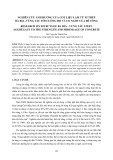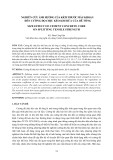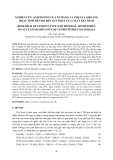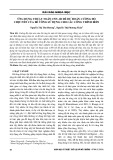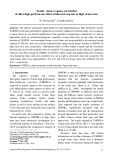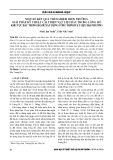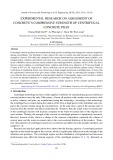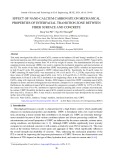
ScienceDirect
Available online at www.sciencedirect.com
Procedia Manufacturing 51 (2020) 1395–1402
2351-9789 © 2020 The Authors. Published by Elsevier Ltd.
This is an open access article under the CC BY-NC-ND license (https://creativecommons.org/licenses/by-nc-nd/4.0/)
Peer-review under responsibility of the scientific committee of the FAIM 2021.
10.1016/j.promfg.2020.10.194
10.1016/j.promfg.2020.10.194 2351-9789
© 2020 The Authors. Published by Elsevier Ltd.
This is an open access article under the CC BY-NC-ND license (https://creativecommons.org/licenses/by-nc-nd/4.0/)
Peer-review under responsibility of the scientific committee of the FAIM 2021.
Available online at www.sciencedirect.com
ScienceDirect
Procedia Manufacturing 00 (2020) 000–000
www.elsevier.com/locate/procedia
2351-9789 © 2020 The Authors. Published by Elsevier Ltd.
This is an open access article under the CC BY-NC-ND license https://creativecommons.org/licenses/by-nc-nd/4.0/)
Peer-review under responsibility of the scientific committee of the FAIM 2020.
30th International Conference on Flexible Automation and Intelligent Manufacturing (FAIM2021)
15-18 June 2021, Athens, Greece.
Production Process Analysis and Improvement of Corrugated Cardboard
Industry
T. Pereira
a,d
, A. S. L. Neves
b
, F. J. G. Silva
a,*
, R. Godina
c
, L. Morgado
a
,
G. F. L. Pinto
a,d
a
ISEP—School of Engineering, Polytechnic of Porto, 4249-015 Porto, Portugal
b
Department of Mechanical Engineering, Polytechnic Institute of Viseu, 3504-510 Viseu, Portugal
c
UNIDEMI, Faculty of Science and Technology (FCT), Universidade NOVA de Lisboa, 2829-516 Caparica, Portugal
d
CIDEM - Centre for Research & Development in Mechanical Engineering, School of Engineering of Porto, Polytechnic of Porto, Portugal
* Corresponding author. Tel.: +351 228340500; fax: +351228321159. E-mail address: fgs@isep.ipp.pt
Abstract
This work was developed into a corrugated cardboard industrial company. In this sector are produced plans resulting from the union between
corrugated cardboard produced and the sheets printed in the previous sector. The PDCA cycle was the main methodology used in this work.
Firstly, the initial state of the production was analyzed by data collection in both existent lines and it was concluded that a great variability of the
parameters was being used in the process for similar works. The main problems in the process were identified and it was concluded that warp
and detached plans were the main reasons for concern. It was implemented a set of measures to reduce these incidences. Control charts were
implemented to the starch glue and through the analysis of these charts and cause-effect diagrams several changes to the starch glue circuit and
to its own recipe were implemented. The steam pressure of the boiler was reduced from 12 bar to 8 bar and a table with temperatures regarding
each paper weight was implemented. The results obtained show that the percentage of waste in the sector was reduced from values ranging
between 9 and 12% to values around 4%. Regarding starch glue consumption, it dropped from 11 g/m
2
to 8 g/m
2
. The energy consumption,
namely gas, showed a saving of 9%. Thus, this work represents an important contribute to the sector, allowing energy savings and quality and
competitiveness improvements.
© 2020 The Authors. Published by Elsevier Ltd.
This is an open access article under the CC BY-NC-ND license https://creativecommons.org/licenses/by-nc-nd/4.0/)
Peer-review under responsibility of the scientific committee of the FAIM 2020.
Keywords: Cardboard industry; lean manufacturing, corrugated cardboard; waste reduction, quality tools, energy consumption.
1. Introduction
The productive processes of companies must be designed
and established in order to make companies more efficient and
competitive. For this, it is important to make them not only
efficient in terms of the use of resources, but also in reducing
waste and thus enabling the increase of economic benefits.
The use of corrugated cardboard for the production of
packaging dates back to 1897 [1] and has since been widely
used [2]. Lightness, low cost and the possibility of recycling [1]
are the main reasons for its increasingly significant use.
Corrugated cardboard is composed of two flat outer sheets
(liners or facings) of puncture-resistant paper with a central
layer of corrugated paper (fluted paper or “medium”) that gives
the packaging resistance to crushing, and protection of the
contents of the packaging [1]. These parts are bonded by starch
adhesives derived from corn, wheat or potatoes [1].
This work was performed in a company devoted to the
manufacture of cardboard or corrugated cardboard packaging,
with offset printing. In this company, the counter gluing sector,
fundamental for the design of the packaging and for its final
quality, presented several problems, such as product warping,
bad gluing, excessive glue consumption and high waste
associated with the process. Thus, the objective of the present
study was to reduce or eliminate the problems existing in the
production process in the counter gluing sector, in order to
Available online at www.sciencedirect.com
ScienceDirect
Procedia Manufacturing 00 (2020) 000–000
www.elsevier.com/locate/procedia
2351-9789 © 2020 The Authors. Published by Elsevier Ltd.
This is an open access article under the CC BY-NC-ND license https://creativecommons.org/licenses/by-nc-nd/4.0/)
Peer-review under responsibility of the scientific committee of the FAIM 2020.
30th International Conference on Flexible Automation and Intelligent Manufacturing (FAIM2021)
15-18 June 2021, Athens, Greece.
Production Process Analysis and Improvement of Corrugated Cardboard
Industry
T. Pereira
a,d
, A. S. L. Neves
b
, F. J. G. Silva
a,*
, R. Godina
c
, L. Morgado
a
,
G. F. L. Pinto
a,d
a
ISEP—School of Engineering, Polytechnic of Porto, 4249-015 Porto, Portugal
b
Department of Mechanical Engineering, Polytechnic Institute of Viseu, 3504-510 Viseu, Portugal
c
UNIDEMI, Faculty of Science and Technology (FCT), Universidade NOVA de Lisboa, 2829-516 Caparica, Portugal
d
CIDEM - Centre for Research & Development in Mechanical Engineering, School of Engineering of Porto, Polytechnic of Porto, Portugal
* Corresponding author. Tel.: +351 228340500; fax: +351228321159. E-mail address: fgs@isep.ipp.pt
Abstract
This work was developed into a corrugated cardboard industrial company. In this sector are produced plans resulting from the union between
corrugated cardboard produced and the sheets printed in the previous sector. The PDCA cycle was the main methodology used in this work.
Firstly, the initial state of the production was analyzed by data collection in both existent lines and it was concluded that a great variability of the
parameters was being used in the process for similar works. The main problems in the process were identified and it was concluded that warp
and detached plans were the main reasons for concern. It was implemented a set of measures to reduce these incidences. Control charts were
implemented to the starch glue and through the analysis of these charts and cause-effect diagrams several changes to the starch glue circuit and
to its own recipe were implemented. The steam pressure of the boiler was reduced from 12 bar to 8 bar and a table with temperatures regarding
each paper weight was implemented. The results obtained show that the percentage of waste in the sector was reduced from values ranging
between 9 and 12% to values around 4%. Regarding starch glue consumption, it dropped from 11 g/m
2
to 8 g/m
2
. The energy consumption,
namely gas, showed a saving of 9%. Thus, this work represents an important contribute to the sector, allowing energy savings and quality and
competitiveness improvements.
© 2020 The Authors. Published by Elsevier Ltd.
This is an open access article under the CC BY-NC-ND license https://creativecommons.org/licenses/by-nc-nd/4.0/)
Peer-review under responsibility of the scientific committee of the FAIM 2020.
Keywords: Cardboard industry; lean manufacturing, corrugated cardboard; waste reduction, quality tools, energy consumption.
1. Introduction
The productive processes of companies must be designed
and established in order to make companies more efficient and
competitive. For this, it is important to make them not only
efficient in terms of the use of resources, but also in reducing
waste and thus enabling the increase of economic benefits.
The use of corrugated cardboard for the production of
packaging dates back to 1897 [1] and has since been widely
used [2]. Lightness, low cost and the possibility of recycling [1]
are the main reasons for its increasingly significant use.
Corrugated cardboard is composed of two flat outer sheets
(liners or facings) of puncture-resistant paper with a central
layer of corrugated paper (fluted paper or “medium”) that gives
the packaging resistance to crushing, and protection of the
contents of the packaging [1]. These parts are bonded by starch
adhesives derived from corn, wheat or potatoes [1].
This work was performed in a company devoted to the
manufacture of cardboard or corrugated cardboard packaging,
with offset printing. In this company, the counter gluing sector,
fundamental for the design of the packaging and for its final
quality, presented several problems, such as product warping,
bad gluing, excessive glue consumption and high waste
associated with the process. Thus, the objective of the present
study was to reduce or eliminate the problems existing in the
production process in the counter gluing sector, in order to

1396 T. Pereira et al. / Procedia Manufacturing 51 (2020) 1395–1402
2 Author name / Procedia Manufacturing 00 (2020) 000–000
improve the quality of the final product, to reduce costs and
waste, as well as to increase productivity. Therefore, the study
was conducted in order to answer the following research
question: what key parameters exist in the process and how to
standardize them in order to eliminate the variability introduced
by the operator factor? The rest of the article is organized as
follows. Section 2 presents the literature review. Section 3
describes the methodology adopted to achieve the proposed
goals. Section 4 describes the process of the counter-gluing
section and all work carried out in the company, as well as the
proposed changes and corresponding results obtained. Finally,
Section 5 outlines the main conclusions.
2. Literature review
The concept of lean manufacturing originated at Toyota in
the 1980s and this philosophy was developed with the objective
of reducing waste and was defined as an objective on the shop
floor, due to the scarcity of materials, human and financial
resources. This methodology was adopted by many industries
in different countries, due to its cost, quality and flexibility,
suggesting the elimination of activities those do not add any
value to the customer, reducing the generated waste [3-5].
According to the industrial sector [6], the packaging industry
in Portugal has a share of between 3% to 4% of the country’s
Gross Domestic Product (GDP), which is double the world
average, currently on 1.5%. The country produced a total of one
million and 600 thousand tons of packaging in 2014, among
several other packaging materials (cardboard/paper, glass,
polymers and metals). However, the most used is the
cardboard/paper, which represents the lion share of 45% of the
entire production [6]. These values underline the importance of
this industry for the country. Several studies were made in the
recent years regarding improvements made in the cardboard
industry. The environmental assessment through a cleaner
production concept as made for paper and cardboard industry
in Jordan, namely, through a waste audit tool and 5 independent
options were identified as potential improvements [7,8]. In [9]
a closed-loop supply chain for a cardboard recycling network
comprising multiple production stages and suppliers was
addressed and the authors optimize the recycling network
through a mixed integer linear programming model. Other
authors, in [10], applied several lean manufacturing tools,
mainly Single Minute Exchange of Die (SMED), 5S tool and
visual management, in order to improve the performance and
quality of the production processes in a cardboard company and
in the end, an average reduction of 47% in the setup time was
reached. A case study in an Indian manufacturing unit focusing
on the execution of SMED on the corrugation machine in a
cardboard box manufacturing company is addressed in another
recent study [11]. The objective was to decrease all the non-
value-added operations and a reduction of 86.6% in changeover
time was achieved. In [12], a case study made in Brazil in a
cardboard industrial unit, addresses a challenge of cutting
rectangular plates into smaller ones with the objective of
finding through dynamic programming the best patterns to be
cut. The lean manufacturing tool Value Stream Mapping is used
in [13] in order to improve the organization of the cardboard
packaging production process in case study focusing on the
largest producers of cardboard food packaging in Poland. In
[14] the authors focus on the organizational impacts due to
implementation of the ISO 9001 standards and mandatory
certification in Brazilians cardboard companies, a study in
which the authors seek to assess the potential benefits of quality
and the certification. Regarding the related wastes to this
industry an analysis of the production and products of
honeycomb cardboard and its use in the current packaging
industry is addressed in [15], and the authors argue that this type
of cardboard is an environmentally friendly material with
characteristics such as low carbon emissions, green packaging,
which obeys to sustainable development requirements. A study
made in Spain and focusing on the Spanish industry analyzed
the cardboard wastes in an overall study of the waste generated
by the indirect and direct suppliers of the paper industry [16].
Since this industry consumes high quantities of water a rational
application of wastewater management in the cardboard and
paper industry following several sustainability standards was
made [17]. Another study regarding this issue [18], addresses
the wastewater treatment of a cardboard manufacturing plant by
infiltration percolation and the obtained results were success-
fully compared with Moroccan and International standards.
Therefore, many opportunities arise with the potential to
improve the performance and reduce several wastes in the
cardboard industry.
3. Methodology
To achieve the proposed objectives, a methodology based on
the PDCA cycle (Plan, Do, Check, Act) of four stages was
followed [19]. In a first phase, daily data collections were
carried out in the back-gluing sector, in order to carry out an
assessment of its status. Based on these data, statistical control
of the process was carried out [20] and through control letters
for starch glue and cause-effect diagrams [21-22], several
measures were planned to be implemented. In a second phase,
changes to the process were implemented, based on the analysis
carried out in the previous phase. After implementing these
changes, during the third phase, an evaluation of the result of
each one was made. Subsequently, in a fourth phase, as a result
of this assessment, new measures were established.
4. Results and Discussion
The company where this work was developed started its
activity in 1968, devoting itself exclusively at that time to the
typography activity. Currently, its business area is focused on
the production of packaging with offset printing, in cardboard
or corrugated board.
4.1. Counter-gluing section
This section is responsible for the production of the
packaging itself, and works 12 hours a day, for 5 days a week.
There are two distinct lines, each consisting of a corrugator and
a counter glue, internally designated as line 17 and line 19.
Although they almost always work in line, both have the ability
to work independently. The lines differ from each other in the
maximum accepted formats, 142 cm x 142 cm in the case of
Author name / Procedia Manufacturing 00 (2019) 000–000 3
line 17, and 160 cm x 160 cm in the case of line 19, the latter
having the capacity to produce double card.
The principle of operation of the two lines is similar. The
corrugator is responsible for the production of the corrugated
channel, called single face, which then enters the counter-glue,
where the printed or smooth sheet is glued, thus creating a plan
which can contain one or more packages, depending on the
article. Fig. 1 and Fig. 2 show the process diagram and the main
stages of the production process, respectively.
N.º Subtitle
1 Paper Reels
2 Starch Glue
3 Printed Format
4 PVA glue
5 Coil Width and Weight
vis-à-vis the OP
6 Glue Viscosity and
Temperature
7 Channel Making
8 Comparison of the Pallet
Label with OP
9 Channel Counter to
Printed Format
Fig. 1. Diagram of the gluing process.
1 - Coil zone for liner and fluting
2 - Channel manufacturing area
3 - Area for placing printed sheets
4 - Exit area of the plywood plans
Fig. 2. Main stages of the process.
In the second stage of the process, consisting of counter-
gluing the single face, which may have been produced online
or can feed the machine in reel, to previously printed or plain
paper, depending on the article to be produced, some problems
may arise. In this step, a glue applicator unit (Fig. 3), in this
particular case, white PVA glue, is deposited between two
rollers, through taps, applying glue on the top of the corrugated
ridges, with which the printed paper is aligned and adheres (Fig.
4). In the delivery section of a laminator, the board goes through
two distinct drying steps: the first, in which each sheet is
pressed by two rugs and then continue in scale by another
carpet, which gives them the final glue (Fig. 5).
Fig. 3. Glue applicator unit.
Fig. 4. Bonding of printed sheet with single face.
Fig. 5. Area of rugs that give the final bonding.
In this process, poor bonding and product warping are some
of the problems that this type of industry faces. This last defect
is mainly caused by three reasons: moisture imbalance between
the outer and inner sheets, which leads to a warping in the
direction perpendicular to the machine's movement; difference
in tension between the outer and inner sheets, which leads to a
warping in the direction parallel to the machine's movement;
and unbalance of tension in the paper due to the distribution of
fibers, or induced by some mechanical component that leads to
a "twist" warp. In addition to these problems, the boards can
also appear too wet, due to an excessive application of glue, or
too dry, in which the card has a brittle appearance, which can
originate from excessive heat supplied to the card.
4.2. Study of the counter-gluing process
Taking into account the adopted methodology, the PDCA
cycle, it was defined in the planning stage that the counter
gluing section was a fundamental section for the global process
and that due to its weight and the high rate of external
complaints and internal non-conformities, would be the subject
of an in-depth study to improve the process. It was then decided

T. Pereira et al. / Procedia Manufacturing 51 (2020) 1395–1402 1397
Author name / Procedia Manufacturing 00 (2019) 000–000 3
line 17, and 160 cm x 160 cm in the case of line 19, the latter
having the capacity to produce double card.
The principle of operation of the two lines is similar. The
corrugator is responsible for the production of the corrugated
channel, called single face, which then enters the counter-glue,
where the printed or smooth sheet is glued, thus creating a plan
which can contain one or more packages, depending on the
article. Fig. 1 and Fig. 2 show the process diagram and the main
stages of the production process, respectively.
N.º Subtitle
1 Paper Reels
2 Starch Glue
3 Printed Format
4 PVA glue
5 Coil Width and Weight
vis-à-vis the OP
6 Glue Viscosity and
Temperature
7 Channel Making
8 Comparison of the Pallet
Label with OP
9 Channel Counter to
Printed Format
Fig. 1. Diagram of the gluing process.
1 - Coil zone for liner and fluting
2 - Channel manufacturing area
3 - Area for placing printed sheets
4 - Exit area of the plywood plans
Fig. 2. Main stages of the process.
In the second stage of the process, consisting of counter-
gluing the single face, which may have been produced online
or can feed the machine in reel, to previously printed or plain
paper, depending on the article to be produced, some problems
may arise. In this step, a glue applicator unit (Fig. 3), in this
particular case, white PVA glue, is deposited between two
rollers, through taps, applying glue on the top of the corrugated
ridges, with which the printed paper is aligned and adheres (Fig.
4). In the delivery section of a laminator, the board goes through
two distinct drying steps: the first, in which each sheet is
pressed by two rugs and then continue in scale by another
carpet, which gives them the final glue (Fig. 5).
Fig. 3. Glue applicator unit.
Fig. 4. Bonding of printed sheet with single face.
Fig. 5. Area of rugs that give the final bonding.
In this process, poor bonding and product warping are some
of the problems that this type of industry faces. This last defect
is mainly caused by three reasons: moisture imbalance between
the outer and inner sheets, which leads to a warping in the
direction perpendicular to the machine's movement; difference
in tension between the outer and inner sheets, which leads to a
warping in the direction parallel to the machine's movement;
and unbalance of tension in the paper due to the distribution of
fibers, or induced by some mechanical component that leads to
a "twist" warp. In addition to these problems, the boards can
also appear too wet, due to an excessive application of glue, or
too dry, in which the card has a brittle appearance, which can
originate from excessive heat supplied to the card.
4.2. Study of the counter-gluing process
Taking into account the adopted methodology, the PDCA
cycle, it was defined in the planning stage that the counter
gluing section was a fundamental section for the global process
and that due to its weight and the high rate of external
complaints and internal non-conformities, would be the subject
of an in-depth study to improve the process. It was then decided

1398 T. Pereira et al. / Procedia Manufacturing 51 (2020) 1395–1402
4 Author name / Procedia Manufacturing 00 (2020) 000–000
that a survey of the state of the sector would be carried out and
control charts for starch glue would be implemented.
In the second stage of the cycle (Do), an analysis of the state
of the sector was carried out in general, so that there was a
comparison between the situation before and after the
implementation of any change to the process.
During one month, in all the works whose composition of
the papers varied, a daily collection was made in the two
existing lines, of the temperatures used for the liner and fluting,
final temperature obtained from the single face, glue gaps used
and the final planimetry of the work. It is important to mention
that the glue gap reading is not the same on both machines. The
glue gap corresponds to the amount of glue that passes between
the donor roll and the doctor roll in the corrugator. However,
the values by which operators are guided on the machines are
dimensionless.
In line 17, it varies from 10 to 350. An increase in this value
corresponds to a greater opening between the glue rollers and,
consequently, to a greater application of glue. In line 19, it
varies from 0 to 32000, and an increase in this value
corresponds to a smaller opening between the glue rollers and,
therefore, to a lesser application of glue.
With this data collection, during the third stage of the PDCA
cycle, the Check stage, it was concluded that there was a very
large variability in the parameters used for each work. The
temperature for the same type of paper varied widely in
different works. The glue gaps were tended to be high, due to
the difficulties felt, mainly in gluing heavy kraft’s with semi-
chemicals. Keeping in mind this, the objective was to create
recipes for the various combinations of existing papers,
regarding the glue gap and the temperatures to be used on each
paper.
4.2.1. Paper temperatures and glue gap
In the last stage of the PDCA cycle, corresponding to the
Act, the first change introduced in this sector was the reduction
of the vapor pressure on both corrugators. The initial working
vapor pressure was 12 bar, which corresponded to a
temperature for the wave group of about 190°C. This reduction
was carried out in two stages. In a first phase, it was reduced to
10 bar, and in a second phase to 8 bar.
Before this change, regardless of the preheater's hugging
angle, the single face was always produced at a very high
temperature, which sometimes exceeded 100°C. This caused
the water present in the starch glue to evaporate and led to its
crystallization, which resulted in the papers not sticking. To
circumvent this situation, larger glue gaps were used, which led
to high consumption. The purpose of this alteration was that the
corrugated group was at a lower temperature, and that the
papers were supplied with the necessary temperature,
depending on their weight.
After that, it was implemented in the sector the use of a table
with the temperatures that the papers should have at the exit of
the preheaters (Fig. 6), depending on their weight (Table 1).
With this measure, it was intended to standardize the process
and eliminate the operator factor, which introduced variability
in the way the single face was produced.
Fig. 6. Paper preheater.
Table 1. Paper temperature, depending on its weight.
Types of papers depending on their weight Temperatures (°C)
Liner
Kraft (weight > 170 g) 85-90
Kraft (weight < 170 g) 75-80
Fluting
Semi-chemicals (weight > 170 g) 85-90
Semi-chemicals (weight < 170 g) 75-80
Medium (weight > 170 g) 85-90
Medium (90 g < weight < 170 g) 75-80
Medium (weight < 90 g) No contact with
preheater
After decreasing the vapor pressure, and with the introduction
of the temperature table according to the weight of the papers,
tests were started in order to reduce the glue gaps used in the
different works.
These tests were carried out during the normal course of
production. The operators started the production order,
introducing the parameters suitable for the work on the machine.
The value usually used for the glue gap was introduced. As the
plates left the machine and accumulated on the pallet (Fig. 7), the
product's planimetry was observed, and samples were taken to
check the quality of the single face bonding. In relation to the
corrugated, three cuts were made (Fig. 8), one in the central zone,
one on the operator's side and the other on the motor side, and the
quality of the glue was evaluated, both in the direction of the
machine's movement and in the contrary direction.
Fig. 7. Planimetry of the work on the pallet.
Author name / Procedia Manufacturing 00 (2019) 000–000 5
Fig. 8. Glue quality control with starch glue.
If the bonding power was considered to be very good (Fig. 9),
in which it was found that the paper fibers were being pulled out,
lower amounts of glue were tested. It was proceeded again in the
same way, until a limit value has been reached, in which the
bonding started to appear weak.
Fig. 9. Glue quality control with starch glue.
It is important to note that, although the quality of gluing is
very important, the planimetry of the product is also important,
as it influences the speed and quality of the box cutting process,
which happens next. As already mentioned, the warping of the
work is related to an imbalance of humidity between the two
outer papers, and that humidity comes from the paper itself and
the amounts of glue applied. The amount of glue indicated for the
production was not the minimum quantity that only ensure a good
bonding, but the minimum quantity able to ensure good
planimetry of the product.
With these tests, it was possible to significantly reduce glue
consumption, in the order of 2 to 3 g/m
2
. However, this decrease
highlighted problems that were camouflaged by the excess of
glue used. Whenever there was a slowdown in the line, which
could originate in a change of pallet of printed sheets, in a
splicing of a reel in the corrugator, or even by a jam in the
counter-glue, the corrugated board produced in that time was too
dry and brittle and the plans produced were very bent. It was
concluded that this phenomenon was related to the fact that the
liner preheater is not fast enough to act, that is, the liner is no
longer in contact with the preheater. With the machine slowing
down, the paper heated up too much, as it was in contact with the
preheater longer, which, in extreme situations, often led to
crystallization of the glue. On the other hand, the automatic
system in the machine to control the paper temperatures, was too
slow to react, and was not working properly. This system was
replaced by a similar one (Fig. 10), but in which the paper is not
in contact with the preheater when the line slows down, and
whose reaction times are much faster, thus allowing a reduction
in waste associated with this situation.
Fig. 10. Temperature control system as a function of speed.
With the decrease in the amount of starch glue applied, it
was found that the bonding power was superior in the direction
of the machine's movement. This is directly related to the speed
of the glue roll when compared to the speed of the paper. To
correct this situation, the speed of rotation of the glue donor
roller has been corrected, making it 2% slower than the speed
of the paper, thus ensuring that the glue is always applied on
top of the wave crest.
In some studies, there was an “S” shaped warp, in which at
opposite ends of the plate, the tips were raised. This type of
warping is usually caused by an irregular application of glue
along the plane, which is related to a poor fit or wear of the glue
scraper. This scraper has the function of homogeneously
cleaning the doctor roller. This roller must always have a clean
and shiny appearance; otherwise, the product's planimetry may
be compromised. Taking this information into account, the
condition of each scraper was evaluated, individually for each
machine and, in the case of machine 17, on each cassette,
through the aspect of the doctor roller. In the first stage, the
scrapers were adjusted and, in cases where it was no longer
sufficient to resolve the situation, they were exchanged.
4.2.2. Starch glue
In the counter-gluing sector, two different types of glue are
used: starch glue in the corrugator, for the manufacture of the
single face, which is manufactured in the facilities, and PVA
glue to join the single face to the printed or plain sheet, which
is purchased from specialized suppliers.
Starch glue is manufactured on the company's premises, in
an automatic kitchen. The manufacture of starch glue is carried
out following a standard recipe created for this purpose, which
is introduced in the machine's PLC (Programmable Logic
Controller) to achieve the final viscosity. This kitchen has a
powdered starch storage silo, and a silo where this powder is
mixed with water and the other products (Fig. 11).
Fig. 11. Kitchen where starch glue is made.

T. Pereira et al. / Procedia Manufacturing 51 (2020) 1395–1402 1399
Author name / Procedia Manufacturing 00 (2019) 000–000 5
Fig. 8. Glue quality control with starch glue.
If the bonding power was considered to be very good (Fig. 9),
in which it was found that the paper fibers were being pulled out,
lower amounts of glue were tested. It was proceeded again in the
same way, until a limit value has been reached, in which the
bonding started to appear weak.
Fig. 9. Glue quality control with starch glue.
It is important to note that, although the quality of gluing is
very important, the planimetry of the product is also important,
as it influences the speed and quality of the box cutting process,
which happens next. As already mentioned, the warping of the
work is related to an imbalance of humidity between the two
outer papers, and that humidity comes from the paper itself and
the amounts of glue applied. The amount of glue indicated for the
production was not the minimum quantity that only ensure a good
bonding, but the minimum quantity able to ensure good
planimetry of the product.
With these tests, it was possible to significantly reduce glue
consumption, in the order of 2 to 3 g/m
2
. However, this decrease
highlighted problems that were camouflaged by the excess of
glue used. Whenever there was a slowdown in the line, which
could originate in a change of pallet of printed sheets, in a
splicing of a reel in the corrugator, or even by a jam in the
counter-glue, the corrugated board produced in that time was too
dry and brittle and the plans produced were very bent. It was
concluded that this phenomenon was related to the fact that the
liner preheater is not fast enough to act, that is, the liner is no
longer in contact with the preheater. With the machine slowing
down, the paper heated up too much, as it was in contact with the
preheater longer, which, in extreme situations, often led to
crystallization of the glue. On the other hand, the automatic
system in the machine to control the paper temperatures, was too
slow to react, and was not working properly. This system was
replaced by a similar one (Fig. 10), but in which the paper is not
in contact with the preheater when the line slows down, and
whose reaction times are much faster, thus allowing a reduction
in waste associated with this situation.
Fig. 10. Temperature control system as a function of speed.
With the decrease in the amount of starch glue applied, it
was found that the bonding power was superior in the direction
of the machine's movement. This is directly related to the speed
of the glue roll when compared to the speed of the paper. To
correct this situation, the speed of rotation of the glue donor
roller has been corrected, making it 2% slower than the speed
of the paper, thus ensuring that the glue is always applied on
top of the wave crest.
In some studies, there was an “S” shaped warp, in which at
opposite ends of the plate, the tips were raised. This type of
warping is usually caused by an irregular application of glue
along the plane, which is related to a poor fit or wear of the glue
scraper. This scraper has the function of homogeneously
cleaning the doctor roller. This roller must always have a clean
and shiny appearance; otherwise, the product's planimetry may
be compromised. Taking this information into account, the
condition of each scraper was evaluated, individually for each
machine and, in the case of machine 17, on each cassette,
through the aspect of the doctor roller. In the first stage, the
scrapers were adjusted and, in cases where it was no longer
sufficient to resolve the situation, they were exchanged.
4.2.2. Starch glue
In the counter-gluing sector, two different types of glue are
used: starch glue in the corrugator, for the manufacture of the
single face, which is manufactured in the facilities, and PVA
glue to join the single face to the printed or plain sheet, which
is purchased from specialized suppliers.
Starch glue is manufactured on the company's premises, in
an automatic kitchen. The manufacture of starch glue is carried
out following a standard recipe created for this purpose, which
is introduced in the machine's PLC (Programmable Logic
Controller) to achieve the final viscosity. This kitchen has a
powdered starch storage silo, and a silo where this powder is
mixed with water and the other products (Fig. 11).
Fig. 11. Kitchen where starch glue is made.

![Cẩm Nang Xây Dựng: Quy Định Pháp Luật Cần Biết [Chuẩn Nhất]](https://cdn.tailieu.vn/images/document/thumbnail/2025/20251225/tangtuy08/135x160/80661766722918.jpg)

